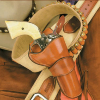Which is, of course, why nothing like those rigs actually existed on the frontier.
Those tied down, metal-lined, thigh holsters were invented for the silver screen. Everything about them is optimized for movie or sport fast draw, and they're no more practical for everyday wear than the race gun holsters IPSC shooters use. As you've observed, the thigh mounted position, which works great for fast draw while standing, is pretty lousy when you're sitting or in the saddle. The metal lining, which was meant to reduce your time to clear leather and get the shot off by allowing you to cock the gun while it's still in the holster, is fine while shooting theatrical blanks. With live ammo, it's a great recipe for putting a bullet into your own leg or foot. And what always killed me about those rigs, is that they were only fast draw after you removed the retaining loop from the hammer; they'd actually be pretty slow to draw from as long as that loop was over the hammer to keep the gun from falling out. Which means you can only be really fast if you're expecting trouble and have time to remove the loop -- you can't walk around with it off, because you're gun will fall out sooner or later, especially riding a horse. But in the real West, they didn't call each other out into the street. Then as now, trouble came suddenly and often unexpectedly.
The real frontier era holsters were softer, not metal lined, and often swallowed all of the gun but the last two or three inches of grip. Keeping the gun secure was the main thing for most people. And in town, people often didn't use a holster at all -- Wyatt Earp, at the OK Corral fight, for example, had his gun in his coat pocket before the shooting started.
























